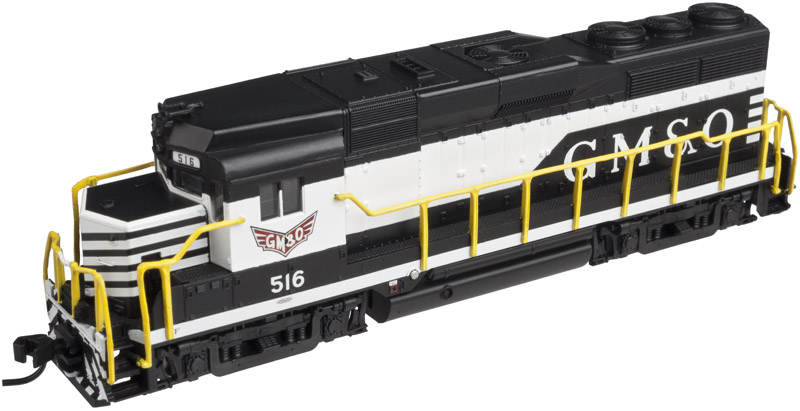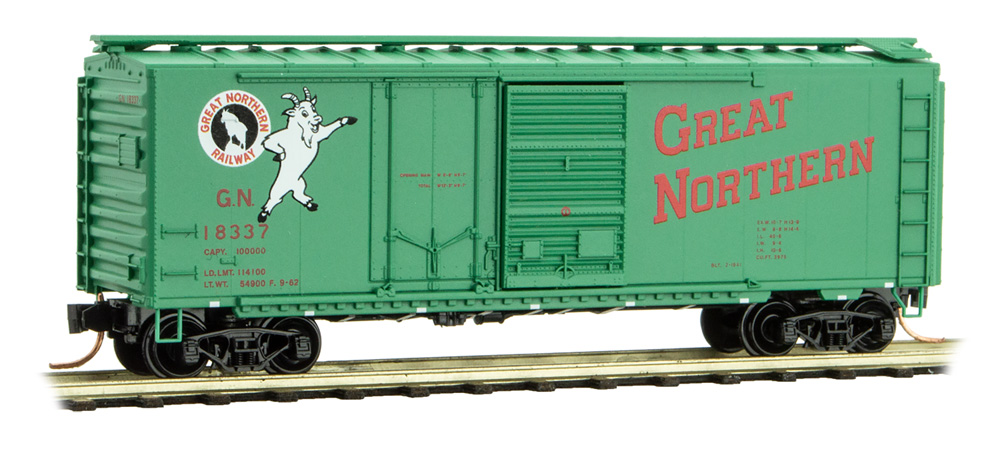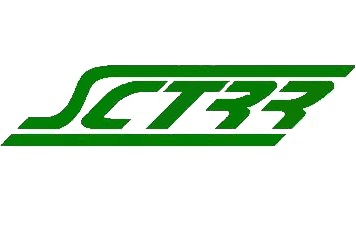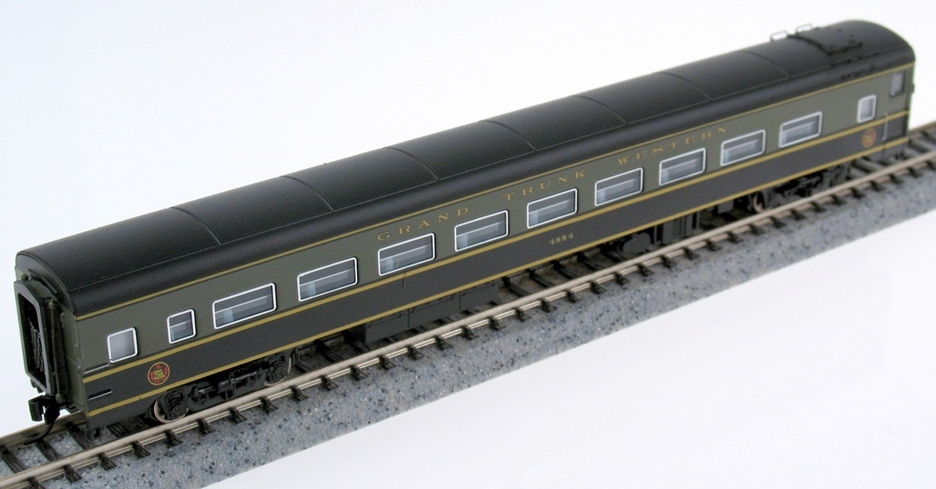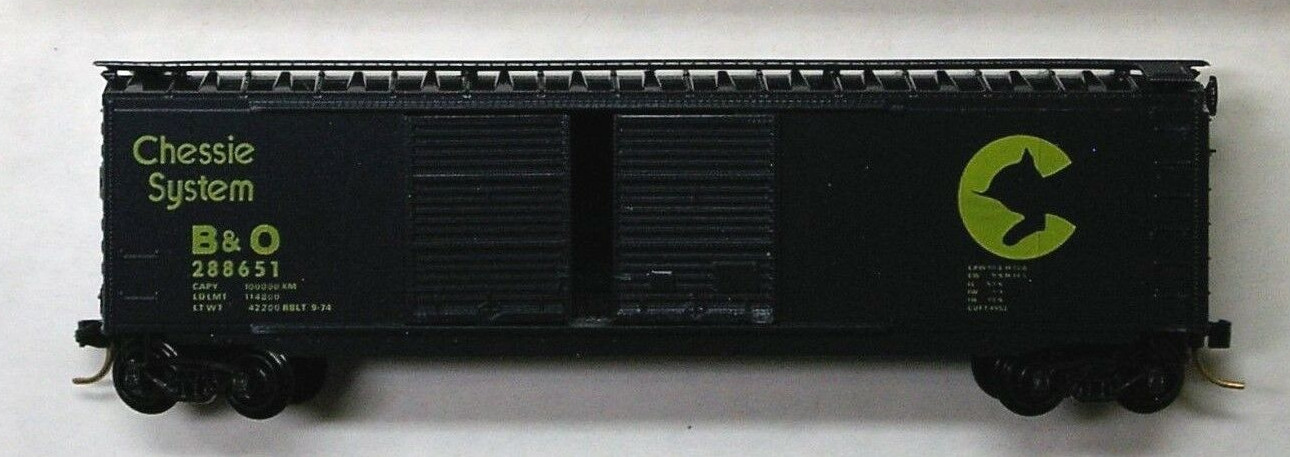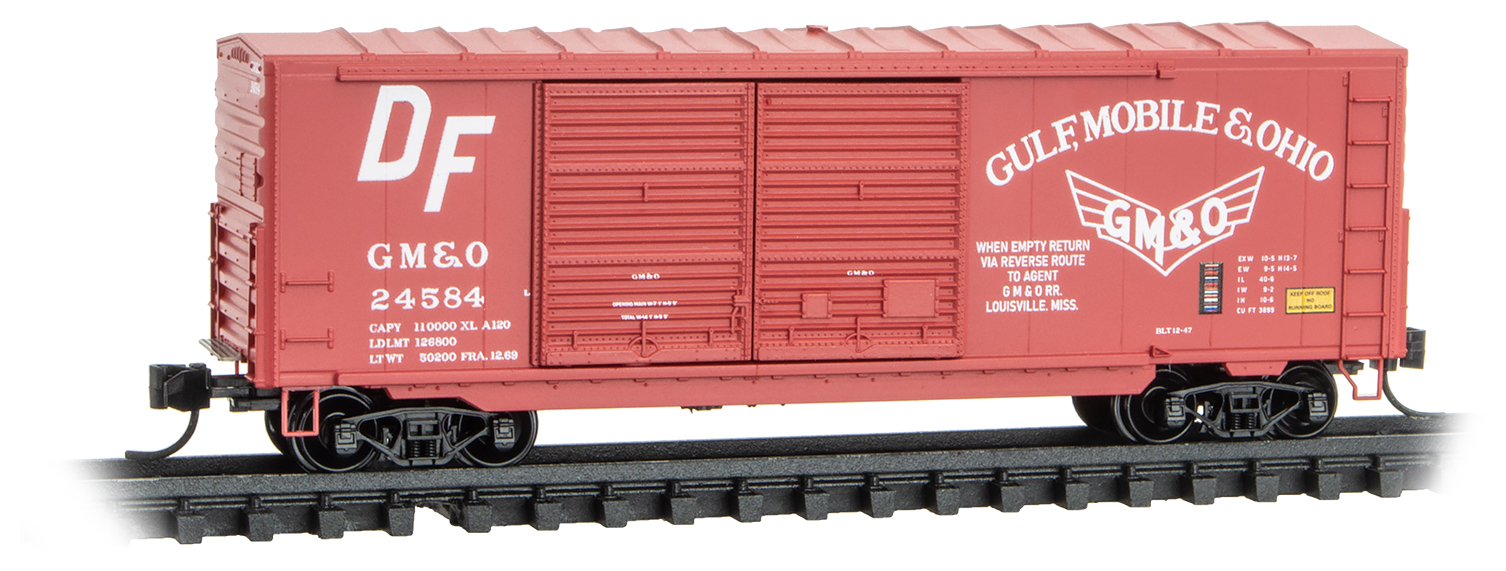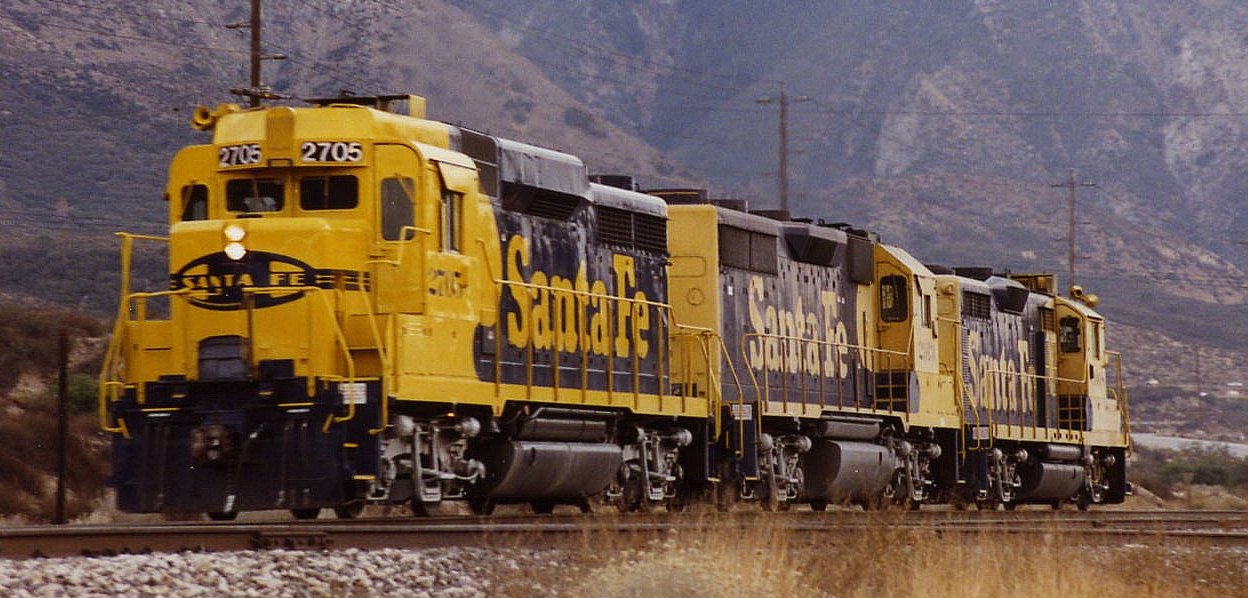Model Information: The first version of this engine was made by Roco for Atlas in 1974. These Austrian-made locomotives were available through the early 1980s. Then, in 1992 Atlas contracted with Kato in Japan to produce a new release of this model. Finally, Atlas switched to Chinese Manufacturing in 1997. They then retooled the Chinese version of the engine for DCC in 2006. The original Kato versions are solid runners with flywheels and body-mounted (Rapido) couplers. They also carry low-profile wheels. Some of the later Rapido-equipped models are easy to swap to MTL couplers by removing a simple plastic clip.
The newest versions are modern split-frame designs with flywheels and a "slow speed" motor with "white" LED lights.
The newest versions are modern split-frame designs with flywheels and a "slow speed" motor with "white" LED lights.
DCC Information: Older versions of this model require a lot of love to make them work with DCC.
Newer models, from 2006 on, accept 1.5 Amp N Scale Board Replacement Mobile Decoder for Atlas GP30 (DN163A4) from Digitrax.com. Be sure that you have one of the newer models in hand before ordering a decoder such as this one.
Newer models, from 2006 on, accept 1.5 Amp N Scale Board Replacement Mobile Decoder for Atlas GP30 (DN163A4) from Digitrax.com. Be sure that you have one of the newer models in hand before ordering a decoder such as this one.
Prototype History: The EMD GP30 is a 2,250 hp (1,680 kW) four-axle B-B diesel-electric locomotive built by General Motors Electro-Motive Division of La Grange, Illinois between July 1961 and November 1963. A total of 948 units were built for railroads in the United States and Canada (2 only), including 40 cabless B units for the Union Pacific Railroad.
It was the first so-called "second generation" EMD diesel locomotive, and was produced in response to increased competition by a new entrant, General Electric's U25B, which was released roughly at the same time as the GP30. The GP30 is easily recognizable due to its high profile and stepped cab roof, unique among American locomotives. A number are still in service today in original or rebuilt form.
From Wikipedia
It was the first so-called "second generation" EMD diesel locomotive, and was produced in response to increased competition by a new entrant, General Electric's U25B, which was released roughly at the same time as the GP30. The GP30 is easily recognizable due to its high profile and stepped cab roof, unique among American locomotives. A number are still in service today in original or rebuilt form.
From Wikipedia
Road Name History:  The GM&O was the product of the 1940 merger of Gulf Mobile & Northern and the Mobile & Ohio. During these early years, the GM&O consisted of a route from St. Louis south to Jackson, Tennessee where it then split into 2 routes to the port of Mobile, Alabama. In addition, there were routes to Memphis, Tennessee; Jackson, Mississippi; and Birmingham and Montgomery, Alabama. GM&O also served New Orleans and Paducah via trackage rights. The merger was championed by Ike Tigrett from the GM&N and Ike would lead the GM&O for most of its history.
The GM&O was the product of the 1940 merger of Gulf Mobile & Northern and the Mobile & Ohio. During these early years, the GM&O consisted of a route from St. Louis south to Jackson, Tennessee where it then split into 2 routes to the port of Mobile, Alabama. In addition, there were routes to Memphis, Tennessee; Jackson, Mississippi; and Birmingham and Montgomery, Alabama. GM&O also served New Orleans and Paducah via trackage rights. The merger was championed by Ike Tigrett from the GM&N and Ike would lead the GM&O for most of its history.
In 1947, GM&O acquired the Alton Railroad. This linked Chicago and Peoria with St. Louis and Kansas City. This acquisition made GM&O a Great Lakes to the Gulf carrier and pushed the mileage up over 2,700. GM&O tried to sell the Kansas City line in the 50’s to Santa Fe and Burlington but there was tremendous pressure from other lines to keep Santa Fe out of St. Louis. In the end, GM&O kept the route and Burlington got trackage rights on a portion of it to shorten its own route.
GM&O dieselized early with the last steam locomotive retired in 1949. The first generation freight diesel fleet included Alco switchers, road switchers (all of which were long-hood-forward,) and FA series cab units and EMD F units. For passenger service, GM&O had power from both Alco and EMD. Everything was painted red and maroon with gold lettering. Both Alton and GM&N had used red in the past so this was appropriate. The oddball of the fleet was #1900, a cab unit model 4-S built by Ingalls Shipbuilding. It was the only locomotive Ingalls would ever build.
The 60’s brought fleets of GP30’s and 35’s. These were delivered on Alco trucks from traded in FA’s and wore a new black and white paint scheme designed by EMD. A few years later, more new power arrived from EMD, this time GP38’s and SD40’s wearing two variations of red and white. First generation diesels still on the roster received solid red or maroon in some cases. The diesel fleet consisted of around 260 units.
As for passenger service, The Rebels ran south of St. Louis with a train each to New Orleans and Mobile. Seven trains a day connected St. Louis and Chicago – more than all other railroads combined between those cities. These included the Abraham Lincoln, Ann Rutledge, and Alton Limited. They also had a single daily Chicago commuter train called The Plug. Amtrak took over three of the Chicago – St. Louis departures in 1971.
By contemporary accounts, GM&O was a class operation with a thin layer of responsive management, esprit de corps in the ranks, and good track - all of this despite serving one of the poorest regions of the country. As the 1960s drew to a close, GM&O faced the impending retirement of the original management team. Because the management layer was so thin, there were few young up-and-comers being groomed to take their places. So, to protect the shareholders, GM&O began shopping for merger partners. In 1972, Gulf Mobile & Ohio merged with Illinois Central to form Illinois Central Gulf.

In 1947, GM&O acquired the Alton Railroad. This linked Chicago and Peoria with St. Louis and Kansas City. This acquisition made GM&O a Great Lakes to the Gulf carrier and pushed the mileage up over 2,700. GM&O tried to sell the Kansas City line in the 50’s to Santa Fe and Burlington but there was tremendous pressure from other lines to keep Santa Fe out of St. Louis. In the end, GM&O kept the route and Burlington got trackage rights on a portion of it to shorten its own route.
GM&O dieselized early with the last steam locomotive retired in 1949. The first generation freight diesel fleet included Alco switchers, road switchers (all of which were long-hood-forward,) and FA series cab units and EMD F units. For passenger service, GM&O had power from both Alco and EMD. Everything was painted red and maroon with gold lettering. Both Alton and GM&N had used red in the past so this was appropriate. The oddball of the fleet was #1900, a cab unit model 4-S built by Ingalls Shipbuilding. It was the only locomotive Ingalls would ever build.
The 60’s brought fleets of GP30’s and 35’s. These were delivered on Alco trucks from traded in FA’s and wore a new black and white paint scheme designed by EMD. A few years later, more new power arrived from EMD, this time GP38’s and SD40’s wearing two variations of red and white. First generation diesels still on the roster received solid red or maroon in some cases. The diesel fleet consisted of around 260 units.
As for passenger service, The Rebels ran south of St. Louis with a train each to New Orleans and Mobile. Seven trains a day connected St. Louis and Chicago – more than all other railroads combined between those cities. These included the Abraham Lincoln, Ann Rutledge, and Alton Limited. They also had a single daily Chicago commuter train called The Plug. Amtrak took over three of the Chicago – St. Louis departures in 1971.
By contemporary accounts, GM&O was a class operation with a thin layer of responsive management, esprit de corps in the ranks, and good track - all of this despite serving one of the poorest regions of the country. As the 1960s drew to a close, GM&O faced the impending retirement of the original management team. Because the management layer was so thin, there were few young up-and-comers being groomed to take their places. So, to protect the shareholders, GM&O began shopping for merger partners. In 1972, Gulf Mobile & Ohio merged with Illinois Central to form Illinois Central Gulf.
Brand/Importer Information: In 1924 Stephan Schaffan, Sr. founded the Atlas Tool Company in Newark, New Jersey. In 1933 his son, Stephan Schaffan, Jr., came to work for his father at the age of sixteen. Steve Jr. built model airplanes as a hobby and frequented a local hobby shop. Being an enterprising young man, he would often ask the owner if there was anything he could do to earn some extra spending money. Tired of listening to his requests, the hobby-store owner threw some model railroad track parts his way and said, "Here, see if you can improve on this".
In those days, railroad modelers had to assemble and build everything from scratch. Steve Jr. created a "switch kit" which sold so well, that the entire family worked on them in the basement at night, while doing business as usual in the machine shop during the day.
Subsequently, Steve Jr. engineered the stapling of rail to fiber track, along with inventing the first practical rail joiner and pre-assembled turnouts and flexible track. All of these products, and more, helped to popularize model railroading and assisted in the creation of a mass-market hobby. The budding entrepreneur quickly outgrew the limitations of a basement and small garage operation. Realizing they could actually make a living selling track and related products, Steve and his father had the first factory built in Hillside, New Jersey at 413 Florence Avenue in 1947. On September 30, 1949, the Atlas Tool Company was officially incorporated as a New Jersey company.
In 1985, Steve was honored posthumously for his inventions by the Model Railroad Industry Association and was inducted into the Model Railroad Industry Hall of Fame in Baltimore, Maryland. In addition, Steve was nominated and entered into the National Model Railroad Association Pioneers of Model Railroading in 1995.
In the early 1990s, the Atlas Tool Company changed its name to Atlas Model Railroad Company, Inc.
In those days, railroad modelers had to assemble and build everything from scratch. Steve Jr. created a "switch kit" which sold so well, that the entire family worked on them in the basement at night, while doing business as usual in the machine shop during the day.
Subsequently, Steve Jr. engineered the stapling of rail to fiber track, along with inventing the first practical rail joiner and pre-assembled turnouts and flexible track. All of these products, and more, helped to popularize model railroading and assisted in the creation of a mass-market hobby. The budding entrepreneur quickly outgrew the limitations of a basement and small garage operation. Realizing they could actually make a living selling track and related products, Steve and his father had the first factory built in Hillside, New Jersey at 413 Florence Avenue in 1947. On September 30, 1949, the Atlas Tool Company was officially incorporated as a New Jersey company.
In 1985, Steve was honored posthumously for his inventions by the Model Railroad Industry Association and was inducted into the Model Railroad Industry Hall of Fame in Baltimore, Maryland. In addition, Steve was nominated and entered into the National Model Railroad Association Pioneers of Model Railroading in 1995.
In the early 1990s, the Atlas Tool Company changed its name to Atlas Model Railroad Company, Inc.
Item created by: gdm on 2016-02-18 18:16:38. Last edited by CNW400 on 2020-08-15 18:13:08
If you see errors or missing data in this entry, please feel free to log in and edit it. Anyone with a Gmail account can log in instantly.
If you see errors or missing data in this entry, please feel free to log in and edit it. Anyone with a Gmail account can log in instantly.


